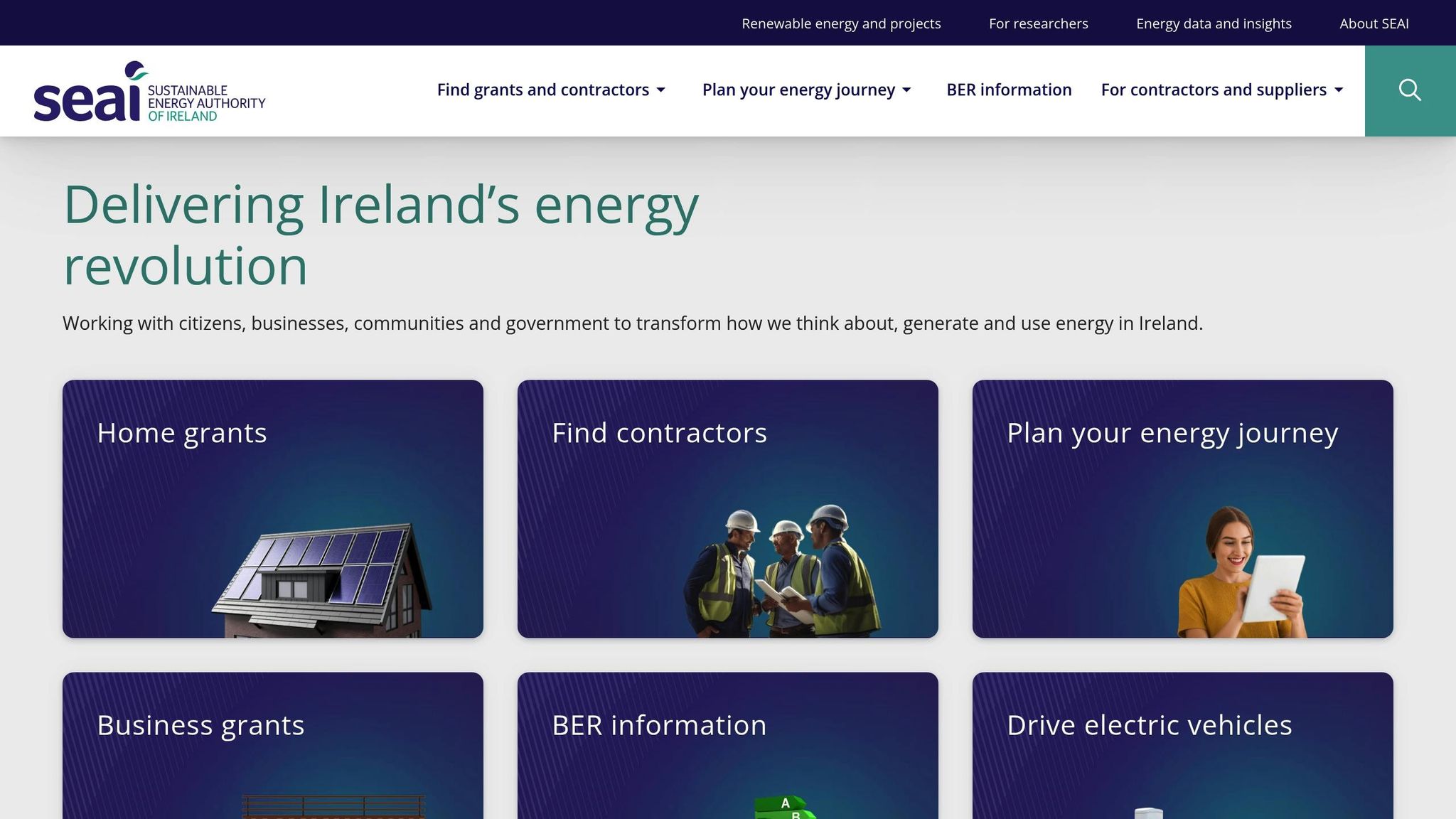Ultimate Guide to SEAI Grant Applications
Learn how to navigate the SEAI grant application process for solar panels, maximizing your savings and ensuring a smooth installation.

The SEAI (Sustainable Energy Authority of Ireland) solar grants make installing solar panels more affordable by reducing upfront costs. These grants are available for homeowners, businesses, and community organizations in Ireland, supporting the shift to renewable energy while lowering energy bills and carbon footprints.
Key Points:
- Grant Amounts: Up to €1,800 for systems of 4 kWp or larger, plus €50 for a Building Energy Rating (BER) assessment.
- Eligibility: Available to property owners, businesses, and public/community organizations with specific documentation requirements.
- Process: Work with SEAI-registered installers, gather necessary documents, and wait for official approval before starting installation.
- Additional Savings: Combine grants with Zero-VAT installations and the Clean Export Guarantee (CEG) to further reduce costs and earn by exporting excess electricity to the grid.
- Common Mistakes: Avoid starting installation before approval, ensure accurate details, and submit complete paperwork.
Act quickly, as grant amounts are expected to decrease annually and end by 2029. Partnering with professionals can simplify the process and maximize benefits.
SEAI Grant Application Process: Step by Step

Finding an SEAI-Registered Installer
The first step in the process is locating an SEAI-registered solar PV installer. Only certified installers - those approved to design, install, and maintain solar panel systems - are eligible for grant funding. Working with a certified installer ensures your system meets SEAI's grant requirements and adheres to their guidelines. Once you've selected your installer, start gathering the required documents to move forward with your application.
Can I Claim the SEAI Grant for Solar PV? - Unlock Solar Savings with SEAI Grants!
Who Can Apply and What Documents You Need
To make your SEAI solar grant application process smoother, it's important to confirm your eligibility and gather the required documents in advance. Whether you're a homeowner, a business owner, or part of a community organization or public sector entity, the requirements vary slightly. Here's what you need to know.
Requirements for Homeowners
Homeowners must provide proof of property ownership for the site where the solar panels will be installed. In some cases, you may also need to submit an energy rating certificate for your property.
Requirements for Businesses and Community Organizations
If you're applying on behalf of a business, you'll need to verify your business registration and provide documentation proving ownership of the site or a valid long-term lease. Public sector organizations - like schools, hospitals, or government facilities - and community energy projects may also need to show evidence that the installation benefits the local community or fulfills a public purpose.
Document Checklist
Having all the necessary paperwork ready will save you time and prevent delays. Typically, you’ll need the following:
- Property Documentation: Documents such as a deed, mortgage statement, or property registration that confirm ownership or legal rights to the property.
- Energy Rating Certificate: A certificate demonstrating your property's energy efficiency.
- Financial Documentation: Proof that you can cover installation costs upfront before receiving grant reimbursement.
- Installer Quotes and Contracts: Detailed quotes and contracts from your solar installer, outlining costs and the scope of work.
- Site Assessment Reports: If applicable, reports confirming the suitability of your property for solar installation, including any special considerations like roof orientation or structural modifications.
- Utility Connection Agreements: Documentation showing that necessary approvals or arrangements with your utility provider for connecting the solar system have been secured.
Double-check that all documents include consistent names, addresses, and property details to avoid any hiccups in processing. Once your eligibility is confirmed and your paperwork is in order, you're ready to proceed with the next steps of your application.
Common Mistakes to Avoid in SEAI Solar Grant Applications
Submitting a grant application for SEAI's solar program can be a detailed process, and even small missteps can lead to delays or disqualification. To help you navigate the process smoothly, here are some common mistakes to steer clear of.
Don't Start Installation Before Getting Approval
One of the biggest errors applicants make is starting the installation or purchasing materials before receiving official approval from SEAI. Doing this can void your grant entirely. If you make any changes to the scope of work or switch contractors without prior approval, your application could be rejected.
Remember, once the installation begins, you can’t cancel the application, and reapplying might result in a reduced grant offer. To avoid these issues, wait until you have the official Letter of Offer in hand before starting any solar PV installation work.
Double-Check All Your Details
Accuracy is key when filling out your application. Double-check that your Meter Point Registration Number, bank details, and address match the official records exactly. Even minor discrepancies can cause significant delays in processing your application.
Make Sure All Documents Are Complete
Incomplete or incorrect documentation is another common stumbling block. Use the SEAI Document Checklist to ensure you’ve included everything required. Installer invoices and quotes should clearly detail the equipment models, quantities, labor costs, and project timelines.
Additionally, ensure your Building Energy Rating (BER) certificate is up to date and applies to the property where the solar panels will be installed. Don’t overlook financial documents proving your ability to cover upfront costs, as SEAI grants operate on a reimbursement basis.
If you need to change your contractor or increase the system size, contact the SEAI Solar PV Team for approval before starting the work. Keeping them informed can save you from costly errors and ensure your application stays on track.
How to Get the Most from Your SEAI Grant
Now that you're familiar with the application process, it's time to focus on making the most of your SEAI grant. Approval is just the first step - thoughtful planning and smart decisions can help you maximize the long-term benefits of your solar investment.
Choosing the Right System Size for Maximum Efficiency
The SEAI grant offers up to €1,800 for systems of 4 kWp or larger. But bigger doesn’t always mean better. The key is to match your solar system size to your actual energy needs rather than solely aiming for the largest grant amount.
For instance, most households consume between 3,500 and 5,000 kWh annually. If your energy use is on the lower end of that spectrum, installing an oversized system could lead to excess energy that doesn’t significantly increase your savings. By selecting a system that aligns with your specific usage, you’ll get the best return on investment.
A 4 kWp system often strikes the right balance for the average household, qualifying for the full grant while meeting typical energy demands. Plus, solar panels usually pay for themselves within 6–9 years and continue to generate savings long after that. Once your system is properly sized, you can explore additional incentives to further reduce costs.
Combining SEAI Grants with Other Incentives
Your SEAI grant is just one piece of the puzzle. Pairing it with other available incentives can make your solar project even more affordable. For example, take advantage of Zero-VAT installations and the Clean Export Guarantee, which allows you to earn money by exporting unused energy back to the grid.
It’s worth noting that solar panel grants are expected to decrease by up to €300 each year and are scheduled to end by 2029. Acting now ensures you benefit from the current incentives while they’re still available.
Expert Help from Get Solar Panels
Navigating the SEAI grant process while designing an efficient solar system can feel overwhelming. That’s where Get Solar Panels comes in. Their team offers professional support to help you maximize your grant and optimize your solar system’s performance.
Their platform provides detailed information on government grants, Zero-VAT installations, and strategies for improving solar efficiency in Ireland’s unique climate. They also share insights on advanced technologies like the Tesla Powerwall and perovskite solar cells, helping you stay ahead of the curve.
Get Solar Panels connects you with SEAI-registered installers who are well-versed in grant requirements. This expertise minimizes application errors and ensures you make the most of your SEAI grant, guiding you toward greater energy independence and long-term savings for your home.
Conclusion
Securing an SEAI solar grant takes careful preparation, close attention to details, and following the application process exactly as outlined. One critical rule: don’t start your installation until SEAI has officially approved your application - doing so will make you ineligible for the grant.
Stick to the required steps without skipping or altering them. Any misstep can delay your grant payment, which usually takes about 4 to 6 weeks to process once all your paperwork is correctly submitted. Partnering with SEAI-registered professionals is key to meeting all the grant requirements smoothly.
The grant offers up to $1,944 (€1,800) for systems of 4 kWp or larger, along with an extra $54 (€50) for a BER assessment on your first application. These savings can make a big difference when investing in solar energy.
Get Solar Panels connects you with SEAI-approved installers who are well-versed in the grant process. They’ll help you avoid costly mistakes and ensure your solar system is designed for optimal performance. This streamlined approach makes your solar investment both affordable and efficient.
FAQs
What are the steps to apply for an SEAI solar grant, and how long does it take to get approved?
To get started with an SEAI solar grant, the first step is registering online and choosing a contractor from their approved list. After that, you’ll need to complete and submit your application. The review and approval process usually takes 4 to 6 weeks.
Once your application is approved, you’ll have 8 months to finish the installation and provide all required documentation. In total, the timeline includes 4 to 8 weeks for application processing, followed by the 8-month window to complete the installation.
How can homeowners and businesses save more by combining SEAI grants with other incentives like Zero-VAT and Clean Export Guarantee payments?
Homeowners and businesses in Ireland have a great opportunity to cut down on solar installation costs by using multiple available incentives. The SEAI grant provides up to €1,800 to help reduce the upfront expenses of installing solar panels. On top of that, the Zero-VAT policy on solar panels makes the initial cost even more affordable.
But that's not all - through the Clean Export Guarantee (CEG), you can actually earn money by exporting any surplus electricity you generate back to the grid. This creates an ongoing financial benefit that adds to the overall value of your solar investment.
By combining these incentives, you can significantly lower your initial costs while enjoying long-term savings, making solar energy a smarter and more economical choice for your energy needs.
What are the most common mistakes to avoid when applying for an SEAI solar grant?
Tips to Avoid Common Mistakes in the SEAI Solar Grant Application Process
Navigating the SEAI solar grant application process can be straightforward if you steer clear of a few common mistakes. Here's what to watch out for:
- Incomplete or inaccurate submissions: Double-check every detail - personal information, property specifics, and required documentation - before hitting submit. Small errors can lead to frustrating delays.
- Skipping essential assessments: If your property requires a BER (Building Energy Rating) assessment, make sure it’s completed before applying. Meeting all prerequisites is a must.
- Starting work prematurely: Don’t jump the gun on installation. Wait until you’ve received the official Letter of Offer to avoid invalidating your application.
- Missing deadlines: Keep a close eye on all timelines. Missing key dates can slow down the approval process or even jeopardize your reimbursement.
Staying organized and thorough throughout the process can save you time and help ensure a smoother path to securing your solar grant.

